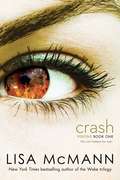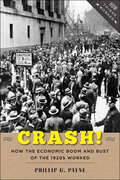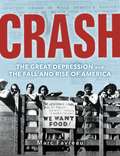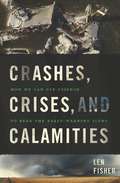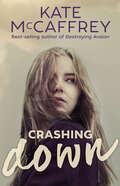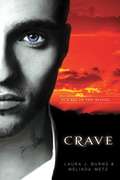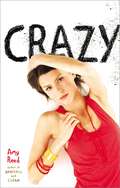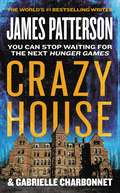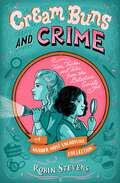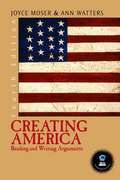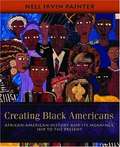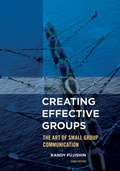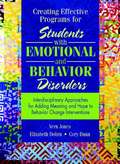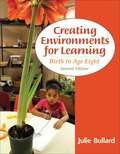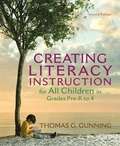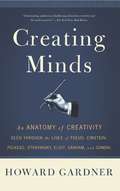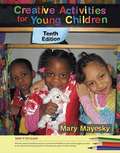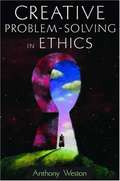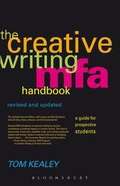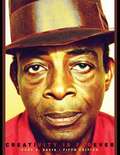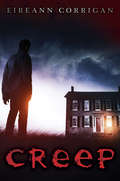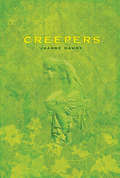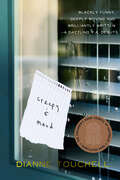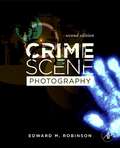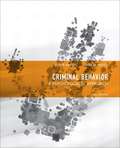- Table View
- List View
Crash (Visions #1)
by Lisa McMannIf what you see is what you get, Jules is in serious trouble. The suspenseful first in a series from the New York Times bestselling author of the Wake trilogy.Jules lives with her family above their restaurant, which means she smells like pizza most of the time and drives their double-meatball-shaped food truck to school. It’s not a recipe for popularity, but she can handle that. What she can’t handle is the recurring vision that haunts her. Over and over, Jules sees a careening truck hit a building and explode...and nine body bags in the snow. The vision is everywhere—on billboards, television screens, windows—and she’s the only one who sees it. And the more she sees it, the more she sees. The vision is giving her clues, and soon Jules knows what she has to do. Because now she can see the face in one of the body bags, and it’s someone she knows. Someone she has been in love with for as long as she can remember. In this riveting start to a gripping series from New York Times bestselling author Lisa McMann, Jules has to act—and act fast—to keep her vision from becoming reality.
Crash!: How the Economic Boom and Bust of the 1920s Worked (How Things Worked)
by Phillip G. PayneThe irrationally exuberant highs and lows of the 1920s can help students recognize boom and bust cycles past, present, and future.Speculation—an economic reality for centuries—is a hallmark of the modern U.S. economy. But how does speculation work? Is it really caused, as some insist, by popular delusions and the madness of crowds, or do failed regulations play a greater part? And why is it that investors never seem to learn the lessons of past speculative bubbles? Crash! explores these questions by examining the rise and fall of the American economy in the 1920s.Phillip G. Payne frames the story of the 1929 stock market crash within the booming New Era economy of the 1920s and the bust of the Great Depression. Taking into account the emotional drivers of the consumer market, he offers a clear, concise explanation of speculation's complex role in creating one of the greatest financial panics in U. S. history.Crash! explains how postWorld War I changes in the global financial markets transformed the world economy, examines the role of boosters and politicians in promoting speculation, and describes in detail the disastrous aftermath of the 1929 panic. Payne's book will help students recognize the telltale signs of bubbles and busts, so that they may become savvier consumers and investors.
Crash: The Great Depression and the Fall and Rise of America
by Marc FavreauThe incredible true story of how real people weathered one of the most turbulent periods in American history—the Great Depression—and emerged triumphant. From the sweeping consequences of the stock market crash to the riveting stories of individuals and communities caught up in a real American dystopia, discover how the country we live in today was built in response to a time when people from all walks of life fell victim to poverty, insecurity, and fear. Meet fascinating historical characters like Herbert Hoover, Franklin Delano and Eleanor Roosevelt, Frances Perkins, Dorothea Lange, Walter White, and Mary McLeod Bethune. See what life was like for regular Americans as the country went from the highs of the Roaring Twenties to the lows of the Great Depression, before bouncing back again during World War II. Explore pivotal scenes such as the creation of the New Deal, life in the Dust Bowl, the sit-down strikes in Michigan, the Scottsboro case, and the rise of Father Coughlin. Packed with photographs and firsthand accounts, and written with a keen understanding of the upheaval of the 1930s, Crash shares the incredible story of how America survived—and, ultimately, thrived.
Crashes, Crises, and Calamities: How We Can Use Science to Read the Early-Warning Signs
by Len FisherWhy do certain civilizations, societies, and ecosystems collapse? How does the domino effect relate to the credit crunch? When can mathematics help explain marriage? And how on earth do toads predict earthquakes? The future is uncertain. But science can help foretell what lies ahead. Drawing on ecology and biology, math and physics, Crashes, Crises, and Calamities offers four fundamental tools that scientists and engineers use to forecast the likelihood of sudden change: stability, catastrophe, complexity, and game theories. In accessible prose, Len Fisher demonstrates how we can foresee and manage events that might otherwise catch us by surprise. At the cutting edge of science, Fisher helps us find ways to act before a full-fledged catastrophe is upon us. Crashes, Crises, and Calamities is a witty and informative exploration of the chaos, complexity, and patterns of our daily lives.
Crashing Down
by Kate McCaffreyLucy is under pressure to succeed and needs to focus on her end-of-year exams—the last thing she needs now is an intense boyfriend. Even though Carl loves Lucy, breaking up with him feels like the only way to keep her dreams on track. But sometimes even right decisions can have awful consequences. Carl crashes his car, breaking his best friend's neck and leaving himself in a coma. Meanwhile, Lucy discovers that she's pregnant. What unfolds is a complex drama, full of unexpected twists and turns that will keep teen readers hooked until the very end.
Crave: Crave
by Laura J. Burns Melinda MetzShay has had a rare blood disorder since she was born. In fact, her mother married one of Shay's doctors, Martin, who left his world-renowned leukemia research to try and figure out exactly what the disorder is and how to cure it. When she turns seventeen, Martin begins to give her new blood transfusions that make her feel the strongest she has ever felt. But she also has odd visions where she sees through the eyes of a vampire. At first, she thinks she must be imagining the visions, but when she begins to see Martin's office in them, she knows she has to check it out. That's when she finds Gabriel, a sexy, teenaged vampire, imprisoned in Martin's office. The connection she has built with Gabriel compels her to set him free. But when he kidnaps her in an attempt at revenge on Martin, their lives become deeply intertwined. She doesn't know the half of it.
Crazy
by Amy ReedHe’s falling in love—and she’s falling over the edge of sanity. From the author of Beautiful and Clean, a “real and relatable” (VOYA) exploration of a romance marred by mental illness.What if I can’t ever be who you want me to be? Connor knows that Izzy will never fall in love with him the way he’s fallen for her. But somehow he’s been let into her crazy, exhilarating world and become her closest confidante. The closer they get, however, the more Connor realizes that Izzy’s highs are too high and her lows are too low. And the frenetic energy that makes her shine is starting to push her into a much darker place. As Izzy’s behavior gets increasingly erratic and self-destructive, Connor gets increasingly desperate to stop her from plummeting. He knows he can’t save her from her pain...but what if no one else can?
Crazy House (Crazy House #1)
by James PattersonThe heart-pounding New York Times bestselling thriller!There were no charges. There was no trial. There will be no escape. In the United, the population is strictly regulated, disease has been eradicated, and crime is nonexistent. Seventeen-year-old Cassie has never stepped out of line. When she tries to tell people that her suddenly missing twin, Becca, is in trouble, no one believes Cassie because Becca was always causing trouble. Except Cassie knows the truth: Becca is the ninth kid to go missing this year. And none of them have come back. Meanwhile, Becca wakes up in Crazy House, a maximum-security prison. All the prisoners are kids, like her. And death is the only way out. Her only hope is that perfect little Cassie starts breaking the rules to look for her…Crazy House is a non-stop thrill ride from James Patterson, the #1 bestselling author of Maximum Ride, Witch and Wizard, and Confessions of a Murder Suspect.
Cream Buns and Crime: Tips, Tricks, and Tales from the Detective Society (A Murder Most Unladylike Mystery)
by Robin StevensLearn more about Daisy and Hazel&’s detecting process and unravel three brand-new mini-mysteries in this short story companion to the Murder Most Unladylike series.Daisy Wells and Hazel Wong are famous for the murder cases they have solved—but there are many other mysteries in the pages of Hazel&’s casebook, including the macabre Case of the Deepdean Vampire, the baffling Case of the Blue Violet, and even their very first case of all: the Case of Lavinia&’s Missing Tie. Packed with these brilliant new mini-mysteries and peppered with Daisy and Hazel&’s own detecting tips, tricks, and facts, this is the perfect book for fans and budding members of the Detective Society.
Creating America: Reading and Writing Arguments (Fourth Edition)
by Joyce Moser Ann WattersThematic argument reader with rhetoric (writing guide) on arguments presents selections and images that depict the political and social changes in America from the Revolutionary War to the twenty-first century. Its argumentative focus will teach readers how to persuade others through written words and visual ideas. High Interest topics including 27 new essays, 4 films, and 10 advertisements/pieces of art; information on visual arguments and online research; an in-depth examination of one country's culture within a range of cultures over time. For persuasive writers.
Creating Black Americans: African-American History and Its Meanings, 1619 to the Present
by Nell Irvin PainterHere is a magnificent account of a past rich in beauty and creativity, but also in tragedy and trauma. Eminent historian Nell Irvin Painter blends a vivid narrative based on the latest research with a wonderful array of artwork by African American artists, works which add a new depth to our understanding of black history. Painter offers a history written for a new generation of African Americans, stretching from life in Africa before slavery to today's hip-hop culture. The book describes the staggering number of Africans--over ten million--forcibly transported to the New World, most doomed to brutal servitude in Brazil and the Caribbean. Painter looks at the free black population, numbering close to half a million by 1860 (compared to almost four million slaves), and provides a gripping account of the horrible conditions of slavery itself. The book examines the Civil War, revealing that it only slowly became a war to end slavery, and shows how Reconstruction, after a promising start, was shut down by terrorism by white supremacists. Painter traces how through the long Jim Crow decades, blacks succeeded against enormous odds, creating schools and businesses and laying the foundations of our popular culture. We read about the glorious outburst of artistic creativity of the Harlem Renaissance, the courageous struggles for Civil Rights in the 1960s, the rise and fall of Black Power, the modern hip-hop movement, and two black Secretaries of State. Painter concludes that African Americans today are wealthier and better educated, but the disadvantaged are as vulnerable as ever. Painter deeply enriches her narrative with a series of striking works of art--more than 150 in total, most in full color--works that profoundly engage with black history and that add a vital dimension to the story, a new form of witness that testifies to the passion and creativity of the African-American experience. * Among the dozens of artists featured are Romare Bearden, Elizabeth Catlett, Beauford Delaney, Jacob Lawrence, and Kara Walker * Filled with sharp portraits of important African Americans, from Olaudah Equiano (one of the first African slaves to leave a record of his captivity) and Toussaint L'Ouverture (who led the Haitian revolution), to Harriet Tubman and Sojourner Truth, to Martin Luther King, Jr. and Malcolm X
Creating Effective Groups: The Art of Small Group Communication (Third Edition)
by Randy FujishinThis practical book gives students the fundamental knowledge and skills necessary to communicate more effectively and interact more productively in the small group setting. With the help of this book, any group member can learn the skills necessary to participate in and lead a task group in an effective, productive, and healthy manner. This third edition features all new sections on: . "The Power of Diversity" . "Critically Thinking About Yourself As A Communicator" . "Defensive vs. Supportive Climates" . "Ethical Communication" . "Time Management" . "Impromptu Speaking" . "The Spirit of Collaboration" As well as new end chapter exercises in several chapters focusing on Online Resources and Social Media. "
Creating Effective Programs for Students with Emotional and Behavior Disorders
by Cory Dunn Elizabeth Dohrn Vern JonesThis exiting new book provides special educators, school psychologists, and others responsible for programs for students serving students with EBD with specific methods, supported by sound research and proven by practice, for developing or improving services to this student population. While several current books provide excellent discussions concerning characteristics of students with EBD and describe some methods that have been effective in helping these students improve their behavior, this is the only book to provide a thorough, comprehensive examination of concepts and strategies needed to effectively develop and implement a program for this student population. special educators, school psychologists, therapists.
Creating Environments for Learning: Birth to Age Eight (Second Edition)
by Julie BullardThis book is designed for college courses taught at institutions that focus on quality early childhood learning environments and curriculum.
Creating Literacy Instruction For All Children In Grades Pre-K to 4
by Thomas G. GunningIn response to today's need to tailor instruction for the lower grades (PreK-4), this comprehensive, practical guide gives aspiring and practicing professionals the methods and techniques they need to become highly effective teachers who are well equipped to help all students become proficient readers and writers. Creating Literacy Instruction for All Children in Grades Pre-K to 4 features lesson plans for virtually every major literacy skill or strategy, abundant lists of recommended children's reading, helpful student strategies, numerous reinforcement activities, and real-life illustrations of exemplary teaching, all designed to help teachers incorporate today's most effective teaching methods and techniques into their literacy teaching.
Creating Minds: An Anatomy of Creativity as Seen Through the Lives of Freud, Einstein, Picasso, Stravinsky, Eliot, G
by Howard GardnerThe man who revolutionized our understanding of intelligence now gives us a pathbreaking view of creativity, along with riveting portraits of seven figures who each reinvented an area of human endeavor. Understanding their diverse achievements not only sheds light on the nature of creativity but also elucidates the “modern era”-the times that formed them and that they in turn helped to define.
Creative Activities For Young Children (Tenth Edition)
by Mary MayeskyCREATIVE ACTIVITIES FOR YOUNG CHILDREN, 10th Edition, is a terrific book filled with fun, creative, and easy-to implement activities for young children. You'll be encouraged to exercise your own creativity, as well as learn how to help young children do the same. Hundreds of activities, up-to-date research, recipes, finger plays, information on how to select children's books, and more make this book an invaluable resource for you and others planning to work creatively with children across the curriculum--and one you'll want to keep for use throughout your professional career.
Creative Problem-Solving In Ethics
by Anthony WestonA readable and insightful guide to ethical dilemmas.
Creative Writing MFA Handbook: A Guide for Prospective Graduate Students (2nd Edition)
by Tom KealeyRevised and Updated! The Creative Writing MFA Handbook guides prospective graduate students through the difficult process of researching, applying to, and choosing graduate schools in creative writing. The handbook includes profiles of fifty creative writing programs, guidance through the application process, advice from current professors and students including George Saunders, Aimee Bender, Tracy K. Smith, and Geoffrey Wolff, and the most comprehensive listings of graduate writing programs in and outside the United States. The handbook also includes special sections about Low-Residency writing programs, Ph. D. programs, publishing in literary journals, and workshop and teaching advice. In a remarkably concise, user-friendly fashion,The Creative Writing MFA Handbook answers as many questions as possible, and is packed with information, advice, and experience. This second edition updates and builds upon the first edition, which was published in 2005 to great acclaim and contains a vastly expanded ranking of current creative writing programs.
Creativity Is Forever (5th edition)
by Gary A. DavisThis book was prepared for any adult interested in better understanding the topic of creativity, becoming a more creative person, or teaching others to think more creatively. It is true that much about human creativity remains---and will remain---an intriguing mystery. It is difficult indeed to untangle the drives, thoughts images, and inspirations of a Thomas Edison, Georgia O'Keeffe, or Walt Disney. As we will see in Chapter 3, extraordinarily creative people have not understood their own creativeness. However, it also is absolutely true that we do understand much about creativity and creative people---their energetic and curious personalities, their ideas--finding processes and strategies, and the circumstances that support or squelch their lively imaginations and innovative thinking.
Creep
by Eireann CorriganThe haunting tale of a family that moves into a house... and finds that someone -- or something -- does NOT want them there.Olivia is curious about the people moving into 16 Olcott Place. The last family there moved out in the dead of night, and the new family, the Donahues, has no idea why. Olivia becomes fast friends with Janie Donahue . . . so she's there at the house when the first of the letters arrives:--I am the Sentry of Glennon Heights. Long ago I claimed 16 Olcott Place as levy for my guardianship. The walls will not tolerate your trespass. The ceilings will bleed and the windows will shatter. If you do not cease your intrusion, the rooms will soon smell of corpses.--Who is the Sentry? And why does the Sentry want the Donahues out of the house badly enough to kill? As Olivia and Janie explore the house, they find a number of sinister secrets . . . and as they explore their town, they find a hidden history that the Sentry wants to remain hidden forever. You can lock the doors. You can close the windows. But you can't keep the Sentry out. . . .
Creepers
by Joanne DahmeFrom moving to a new house to making new friends and preparing for high school, life for the new girl in town can be unsettling. But thirteen year-old Courtney is unprepared for how creepy life in Murmur, Massachusetts turns out to be. Her ivy-covered house overlooking the antiquated cemetery next door is one thing, but Courtney finds herself thrust into a full-fledged haunted adventure after meeting Christian and Margaret Geyer, a strange father and daughter with unfinished family business. The body of their ancestor, Prudence, has gone missing from beneath her ivy-carved tombstone and must be returned to its final resting place in order to break the spell that looms over Courtney's house. To add to the suspense and help solve the mystery, authentic documents and photographs are set at the beginning of each chapter pertaining to Murmur, Courtney's house, and the infamous cemetery. Will Courtney uncover the secret lurking within the dark, dank underbelly of her ivy-covered basement?
Creepy & Maud
by Dianne TouchellHilarious and heartbreaking, Creepy & Maud charts the relationship between two social misfits, played out in the space between their windows. Creepy is a boy who watches from the shadows keenly observing and caustically commentating on human folly. Maud is less certain. A confused girl with a condition that embarrasses her parents and assures her isolation. Together Creepy and Maud discover something outside their own vulnerability — each other's. But life is arbitrary; and loving someone doesn't mean you can save them. Creepy & Maud is a blackly funny and moving first novel that says; 'You're ok to be as screwed up as you think you are and you're not alone in that.'
Crime Scene Photography (Second Edition)
by Edward M. RobinsonCrime Scene Photography, Second Edition covers the general principals and concepts of photography, while also delving into the more practical elements and advanced concepts of forensic photography. Edward Robinson assists the reader in understanding and applying essential concepts in order to create images that are able to withstand challenges in court. The first part of the book deals with the basic theory and science of photography required to take superior photographs, and covers topics such as composition, exposure, focus, depth of field, and flash techniques. The second part of the text deals specifically with the challenges of photographing a crime scene, including instructions on how to document bodies and wounds, traffic accident photography, underwater photography and aerial photography. In the latter portions of the text, the author turns to digital theory and its advantages and disadvantages. * Over 600 full color photographs, also electronically available on the companion website * Two new chapters on 'The History of Forensic Photography,' and 'Digital Image Processing of Evidentiary Photography' * Includes an Instructor website with lecture slides, practical exercises, a test bank and image collection * An essential reference for crime scene photography, including topics such as Composition, the Inverse Square Law, Court Cases affecting photography, Digital Image Processing, and Photogrammetry * Required reading by the Crime Scene Certification Board of the International Association for Identification (IAI) for all levels of certification
Criminal Behavior: A Psychological Approach (Tenth Edition)
by Curt R. Bartol Anne M. BartolA comprehensive psychological approach to criminal behavior. Accurate, researched-based, contemporary, and comprehensive: Criminal Behavior: A Psychological Approach, Tenth Edition, builds on the excellence established in previous editions. The text offers a detailed look at crime, what may lead to it, and how criminal behavior may be prevented, all from a psychological perspective. Focusing on serious crimes, particularly those involving violence, Criminal Behavior offers a comprehensive look at this complex field with effective and engaging material that has been classroom-tested for over thirty years.
